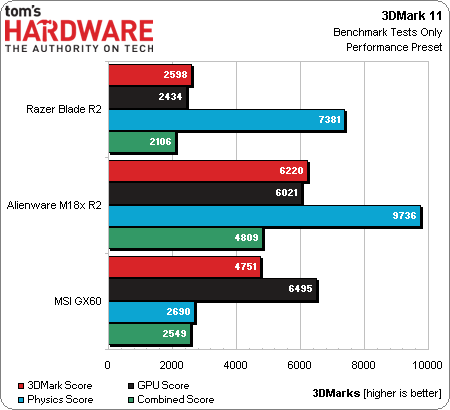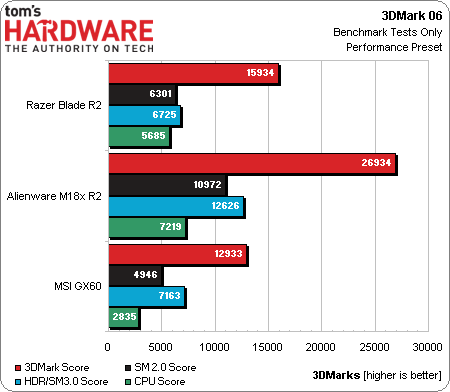Razer's Second-Generation Blade Notebook Review: Focusing On The Z
Razer recently sent us its second-gen Blade, complete with a Core i7-3632QM quad-core CPU and GeForce GTX 660M. Eight gigabytes of memory, a 500 GB hard drive, and an SSD cache round out this 17" gaming notebook. Would you believe it's less than 1" thick?
Synthetic Benchmarks: 3DMark
Our synthetics include 3DMark 11, 3DMark Vantage, and 3DMark 06.
With the latest version of 3DMark available, we know that 3DMark Vantage and 3D Mark 06 show their age. But each still offers unique insight to system performance, letting us compare older hardware you might still have around. As you can see, we're using an Alienware M18x with an Nvidia GeForce GTX 680M and an MSI GX60 with an AMD Radeon HD 7970M. We'll be able to see how the GeForce GTX 660M sizes up to the fastest mobile modules that money can currently buy.
Looking at 3DMark 11, we see that the Blade's GPU is quite a bit slower than the highest-end mobile chips out there (as expected, of course). The GPU-only score of 2,434 is still higher than the typical ~2300 that most 660Ms achieve, or even the GT 650M’s typical 2,050.
Overall scores between the two Nvidia-based machines demonstrate fairly linear scaling. This is to be expected given the faster CPU/GPU combo in the comparison notebook. The Physics subtest yields a nice surprise, thanks to a quad-core Hyper-Threaded processor.
Comparing the Blade to MSI's system reveals more differences. While the Radeon HD 7970M is clearly faster than the Blade's GPU, Intel's Core i7-3632QM walks all over the AMD APU.
In 3DMark Vantage, the GeForce GTX 660M is once again left behind by the 680M and Radeon HD 7970M. However, in this older test, which doesn't employ modern graphics features, the higher-end GeForce is only around twice as fast as the Blade (rather than almost three times faster). As we will see in our real-world benchmarks, which don't tend to be as cutting-edge as synthetics, this Vantage comes closer to reality.
Once again, the Core i7-3632QM shows how fast it is. Against the -3940XM which is the fastest mobile CPU Intel sells, it keeps up in the CPU score pretty well. The A10-4600M falls far enough behind that the Blade is almost able to catch up to the bottlenecked AMD-based machine. We want to point out, though, that the A10-4600M doesn't feel sluggish, despite the synthetic numbers. The APU does well under Windows 7 and 8, and performs well in common tasks. Unfortunately for the dual-module chip, it's up against two true quad-core CPUs.
Get Tom's Hardware's best news and in-depth reviews, straight to your inbox.
The 3DMark 06 scores continue the trend seen previously. Performance in 3D applications appears to be about twice as fast on the GeForce GTX 680M. The CPU sub-test again demonstrates the Core i7-3632QM's speed.
Leaving additional DirectX features off the table takes away the Radeon HD 7970M’s advantage over the GeForce GTX 660M. In fact, the Nvidia GPU outperforms it in nearly every measure. Retro gamers should take note, since this benchmark represents theoretical performance in older titles.
Current page: Synthetic Benchmarks: 3DMark
Prev Page Packaging, Included Media, System Restore Next Page Productivity Benchmarks-
ShadyHamster Having all the I/O on the left isn't such a bad idea, keeps the right side clear so cables don't get in the way if you use a mouse close to your laptop like i do.Reply -
mayankleoboy1 Wow, this is a very thorough review! Great work!Reply
This notebook has looked into almost every possible detail. I was particularly impressed that in the heat run, the "WASD" key area was cooler than the rest. This bespeaks extreme attention to details. -
Chairman Ray This is an amazing system. Great job by Razer! I won't be buying it due to the steep price tag, but definitely going to recommend it to those who are willing to pay for the best.Reply -
xpeh While the price is steep, this laptop is definitely one of the best looking gaming laptops I've ever seen.Reply -
g-unit1111 I very badly need to get a new laptop but this one is way too rich for my blood. I would definitely consider this if it were about $1K less.Reply -
Pyree g-unit1111I very badly need to get a new laptop but this one is way too rich for my blood. I would definitely consider this if it were about $1K less.Lenovo Y580/Y500 GT650m SLIReply -
slomo4sho xpehWhile the price is steep, this laptop is definitely one of the best looking gaming laptops I've ever seen.IMO having a $1000 gaming desktop and spending $500-600 on a laptop when Haswell comes out is probably much more economical for the occasional gaming on a laptop paired with a sold desktop to enjoy the higher quality graphics. Even at $2500, this laptop can't even keep up with the $500 budget gaming build from last month.Reply -
de5_Roy nice review. :)Reply
my real amusement came from the apu-powered laptop's performance, though. it bottlenecked the discreet gpu so badly.... :D -
corvak Gaming laptops have never been priced in a range that makes them worth buying for me. They don't really have enough battery life to really take advantage of portability, and the price/performance is in a whole other league if you compare it to any desktop build.Reply
Even buying a cheap laptop for travel use alongside a gaming desktop is likely to come in cheaper than many of these.
-
Goose_Nipples ARMY'S KA-Bar?!?!?!?! Hooooooold up my friend. Devil dog here who's jimmies have most assuredly been rustled.Reply


